Headed into the 2024 Olympic year, the U.S. men’s swimming team is in an interesting spot. After being led by Caeleb Dressel for the last five years, his eight-month hiatus and failure to qualify for the 2023 World Championships meant that the American men needed to find a new core identity. They struggled to win gold at the World Championships and ended the 2023 calendar year with zero world-leading times, but plenty of new faces with big potential emerged on the scene.
2024 will answer many of our questions about the U.S. men in 2023. In this article, we look at some of the biggest Olympic year storylines for American men’s swimming.
Will Caeleb Dressel Be Back?
Caeleb Dressel may not have completed a senior international meet in over two years, but he’s still the biggest and most talked-about name amongst American male swimmers. So it’s only fair that we dedicate a section to him.
When Dressel competed at U.S. Nationals this June, he was not in shape, failing to get close to a World Championships roster spot. However, at the U.S. Open last week, he showed flashes of his former self. At that meeting he looked the best he has since before he went on hiatus, posting a 21.99 50 free, a 48.85 100 free, and a 51.31 100 fly. While those times don’t indicate that he’s a lock for the Paris Olympic team (in fact, all of his events are slower than what it took to qualify for the Worlds team this year), they are very good for this point in the season and indicate that he’s trending in a positive direction.
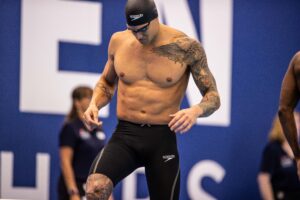
Caeleb Dressel (photo: Jack Spitser)
Dressel’s form in the summer of 2024 will determine many things for the American men. If he’s in peak shape, then he’s a lock to make the Olympic team individually in the 50 free, 100 free, and 100 fly, which would hurt the qualification chances of sprint specialists like Ryan Held, Dare Rose, Michael Andrew, David Curtiss, Brooks Curry, and Jack Alexy. These swimmers hold up on their own, but their path to Paris would be much easier if peak Dressel wasn’t there.
Another thing largely dependent on Dressel’s 2024 form is the success of American relays. He will certainly be a big boost to the men’s 4×100 free relay, where the Americans are viewed as underdogs against a stacked British squad. Had his 47.26 Tokyo Olympic leadoff replaced Held’s 48.16 leadoff from the 2023 World Championships, Team USA would have won gold by 0.25 seconds instead of taking bronze (albeit, this was in a final where Great Britain was DQed). However, the bigger narrative is about Dressel’s presence in the men’s medley relay. The Americans have never lost this relay at the Olympics before, but China finished off 2023 with the world-leading time in the event (3:27.01) — 0.19 seconds faster than what the Americans went to win at Worlds this year, and 0.23 seconds off the world record. In Paris, if the Americans are in the state they were in this summer, then China has a great chance of snapping the Team USA win streak. But a rejuvenated Dressel, whose butterfly relay prowess coincides directly with fly being China’s weakest stroke, could swing the odds in Team’s USA favor.
Here’s some perspective on just how much Dressel can affect the men’s medley relay:
| China, 2023 Asian Games | Team USA, 2023 World Championships | Team USA, 2023 World Championships with Dressel on fly |
| Xu Jiayu — 52.05 | Ryan Murphy — 52.05 | Ryan Murphy — 52.05 |
| Qin Haiyang — 57.63 | Nic Fink — 58.03 | Nic Fink — 58.03 |
| Wang Changhao — 50.68 | Dare Rose — 50.13 | Caeleb Dressel — 49.03 |
| Pan Zhanle — 46.65 | Jack Alexy — 47.00 | Jack Alexy – 47.00 |
| 3:27.01 | 3:27.20 | 3:26.10 |
As you can see, just having Dressel in the vicinity of his best split time would be a big boost to the Americans and help widen the gap between them and the Chinese. Other factors will shape the relay too, such as Xu Jiayu‘s consistency, whether younger swimmers like Pan Zhanle, Jack Alexy, and Rose can keep improving from last year, and the form of aging veterans like Ryan Murphy and Nic Fink. But Dressel’s form will carry the most weight in moving the needle.
How Many Juniors Will Qualify For Paris?
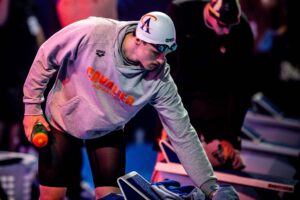
Thomas Heilman (photo: Jack Spitser)
It’s not often that we see high school-aged boys qualify for senior international teams, and it’s even rarer to see multiple high schoolers with a shot at the Olympics. This summer, 16-year-old Thomas Heilman became the youngest male swimmer to qualify for a Worlds or Olympic team since Michael Phelps in 2000, while recently graduated high school senior Henry McFadden also booked a trip to Fukuoka. However, their Worlds berths might just be the beginning of a massive rise of talent among American boys.
Heilman is now a legitimate threat for an individual medal next summer, but there are so many other swimmers his age who have a strong shot at making Paris. One of them is, of course, his classmate and future Virginia teammate Maximus Williamson. Williamson became the fastest 18-and-under American in the history of the 100 free when he clocked a time of 48.38 this summer, which puts him in the mix for a 4×100 relay spot (it took a time of 48.08 to make Worlds last year). In addition, his 1:57.29 200 IM makes him the fastest 17-year-old in the history of the event. Then there’s 18-year-old Daniel Diehl, who finished third at Nationals in the 200 back last summer and was in striking range of a Worlds berth.
17-year-old Kaii Winkler missed all of last season’s major long course meets because of an injury, but don’t forget that he’s the youngest American to break 49 in the 100 free and could be in for even bigger swims next summer. It’s also not a good idea to count out 14-year-old Luka Mijatovic either. His times are still a bit far from what it’s going to take to make the Olympics, but he’s rapidly improving, so he might give some older swimmers a little scare next summer.
Teenagers are often the ones with the highest ceilings. And in a year when American men’s swimming needs emerging talent more than ever, all eyes will be on the youth.
Uh-Oh! Roster Limits!
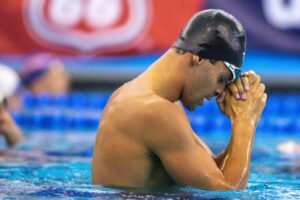
Michael Andrew (photo: Jack Spitser)
At U.S. Nationals, the American men ran into a problem: they had 27 projected qualifiers for the 2023 World Championships, but only 26 roster sports. Due to this, Andrew, the swimmer who ranked lowest in selection priority, missed the Worlds team.
The issue that caused the American men to exceed the roster capacity was a lack of versatile phenoms who could qualify for multiple events and open up space for other swimmers. In the past, they’ve had Michael Phelps and Ryan Lochte do the job. This year, with Dressel being off and other versatile swimmers like Andrew and Shaine Casas underperforming, there was only one male swimmer who made Worlds in three events: Carson Foster.
With stroke 50s out of the picture, it will be easier for Team USA to stay under that 26-person roster limit. However, with the status of so many multi-event contenders still in question, roster limits are still a looming concern. Dressel being off his game will be a problem. Uber-versatile talents such as Andrew and Casas are hot and cold, and if both of them are off like they were last season, that will also create trouble. A lot hinges on how many events Foster will swim (he’s pretty unpredictable in that regard, as his lineup so far has been different for the last two years), or whether the guy who qualifies second behind (likely) Bobby Finke in the 800 free will also make the team in the 1500. Hopefully, a possible multi-event qualifier like Chase Kalisz won’t come down with a case of food poisoning, but what happened to him goes to show that last-minute scratches can have a major impact. More likely than not, especially with stroke 50s being erased and Dressel’s impending comeback, all will go fine. But after what happened last year, the concern of roster limits should always be in the back of our minds.
Another selection procedure-related issue to keep watch for is the limit of 12 relay-only swimmers on the team (male and female combined). The limit affected things in 2021 when Held was the unfortunate 13th-ranked relay swimmer (based on the percentage of his 100 free time to the World Aquatics ‘A’ cut), leaving him off the Tokyo Olympic team even though he finished sixth in the 100 free. At the 2023 U.S. Nationals, all relay-only swimmers were safe, but things were getting cut a bit close, as the Worlds team had 12 relay-only swimmers.
You Get A Redshirt! You Get A Redshirt! We All Get Redshirts!
Like in every other pre-Olympic year, there are numerous amounts of college swimmers who choose to skip out on the NCAA season to take an Olympic redshirt or gap year. This year, however, there are at least ten prominent male swimmers who opted out of the collegiate season in favor of training long course, compared to only five on the women’s side (Texas’s Lydia Jacoby and Jillian Cox, Stanford’s Torri Huske, Virginia’s Claire Curzan, and Tennessee’s Mackenzie Siroky).
List of prominent American male swimmers who took Olympic redshirts/gap years or went pro:
- Carson Foster, Texas (went pro, is done with NCAA)
- David Johnston, Texas
- Matt King, Virginia
- Jack Aikins, Virginia
- Diggory Dillingham, USC
- Zhier Fan, Stanford*
- Charlie Clark, Ohio State*
- Reid Mikuta, Auburn**
- Luca Urlando, Arizona State
- David Curtiss, NC State***
*Fan is redshirting for at least the fall semester, while Clark confirmed that he was doing the same and returning for NCAAs.
**Mikuta told SwimSwam in July 2023 that he was taking an Olympic redshirt. In September 2023, he was arrested on charges of rape.
***Curtiss left NC State to train with the TAC Titans, but is unclear whether he will return to the NCAA or not.
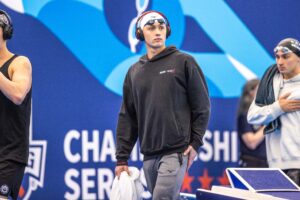
Carson Foster (photo: Jack Spitser)
What’s notable about this list is that half of the swimmers on it have never made an Olympic or World Championships team before, and out of the five who have, only one (Foster) has won an individual Olympic or World Championships medal. That means redshirting could be a major gamble for many of these swimmers — potentially a lot of work for little result. Furthermore, every single one of these swimmers is in a different situation, but all of them have something to chase.
Foster is one of the best and most versatile swimmers in the world, and yet he’s always been a bridesmaid to Leon Marchand, taking silver behind in two years in a row. King was America’s second-best relay swimmer last year and is in the running for an individual 100 free spot. David Johnston and Charlie Clark were on World Championship teams, but neither of them had made a final before and both added significant time from trials to Worlds. Luca Urlando is avenging his 2021 Olympic trials meet, where he finished third in both the 100 and 200 fly and narrowly missed the Tokyo team. Jack Aikins and David Curtiss have been on U.S. National teams before and have been “close, but not quite there” when it comes to making World Championship or Olympic teams. Diggory Dillingham, Zhier Fan, and Reid Mikuta will all need to drop a few seconds to be in the realm of Olympic contention, and it’s unclear whether Mikuta will ever swim again given the charges that he’s facing (he entered the transfer portal this summer and is not on an NCAA roster).
It will be interesting to see how many of these numerous redshirts/gap years end up paying off, and how well the swimmers choosing to take them do compared to those who chose to swim through the NCAA season. Redshirting/gap years bring many opportunities, such as being able to focus on long course and the chance to compete at the 2024 World Championships (which Foster, Johnston, Aikins and King will swim at). However, whether these benefits will be worth it or not is yet to be seen.
Newcomers vs. Veterans
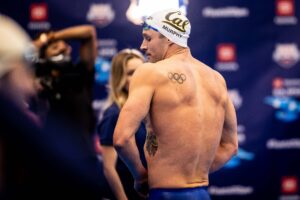
Ryan Murphy (photo: Jack Spitser)
This has been brought up quite a few times in this article already, but the “old vs. new” narrative in American men’s swimming is so prevalent that it deserves its’ own section. So alas, here we are.
Last season was a changing of the guards for the men’s team, with 12 swimmers on the Worlds squad being international meet first-timers. Four additional swimmers were swimming at only their second international meet, which meant that over half the American men were relatively inexperienced on the big stage. Meanwhile, international team mainstays like Dressel and Andrew failed to qualify.
This year might be the final chance for several Team USA veterans to make their mark. Names like Fink and Murphy might not be in situations as precarious as those of Dressel and Andrew, but their spots are still under threat. It feels like Hunter Armstrong (and potentially Destin Lasco) is going to pass Murphy as the team’s top backstroker any day now, while Fink is way past his prime in the 200 breast and was only the clear best 100 breaststroker last year because Andrew underperformed and the event isn’t super deep otherwise. Justin Ress has always relied on finishing top six in the 4×100 free relay to qualify for Worlds, but who knows what will happen in that race. Kalisz has been making international teams in the 400 IM for nearly a decade now, but he seems to be at great and greater risk of being run down by Finke every year.
Meanwhile. last year’s newcomers like Alexy, Rose, Josh Matheny, Luke Hobson, Heilman, Matt Fallon, and Lasco could continue to rise. In addition to them and the high-profile junior swimmers we mentioned earlier, there’s also the possibility that even more first-timers make an impact. For example, swimmers like Jake Foster, Grant House, and Jake Magahey have been knocking on the door of international team qualification for a few years now, and Olympic trials could be their time to finally shine.
Ultimately, the message is simple and clear: we are in a new era of American men’s swimming. And there are many people under threat of being left behind.
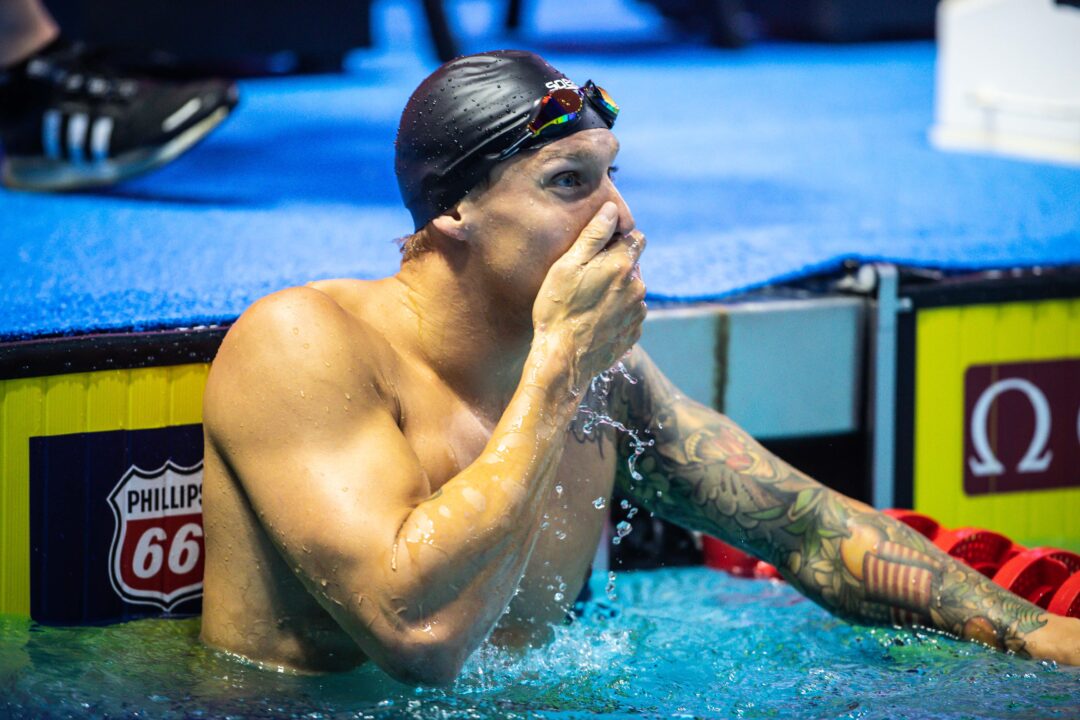
“It feels like Hunter Armstrong (and potentially Destin Lasco) is going to pass Murphy as the team’s top backstroker any day now.”
This feels like a bit of a stretch when Murphy keeps outperforming them. He had a much better year than either Lasco or Armstrong.
MA has one of the hardest qualification paths. 50free will be tough if Dressel and Alexy are both on. 100fly if Dressel and Rose are both on. 100br seems like his best shot depending on what Fink and anyone else do. If he can get the 1st spot, maybe he can get on the Medley relay. He doesn’t seem to want to swim the 2IM presumably because it conflicts with these other events at trials or Olympics.
don’t forget he’s the AR holder in the 100 br…
all he has to do is go within .7 of his PR and he’ll be fine. I would be shocked if anyone else besides fink broke 58.7
I don’t think he has broken 59 since Tokyo. He has been under a minute a couple times at most and sometimes over. He has been in a bit of a breaststroke slump but it has looked a little better recently. He is certainly not a lock for one of the top 2 breaststroke spots. Maybe he will put more time into his breaststroke after Doha since it is his best shot at making the team.
Love the selected photo for the section on roster limits. That made my day.
Very apt!
“This year, with Dressel being off and other versatile swimmers like Andrew and Shaine Casas underperforming,“ – one of the worst takes ever
It is spot on. Unless you’re Andrew or Casas then it probably sucks to hear this. Hopefully it motivates them to work harder and smarter. Dressel is not off just getting back into shape. He will lead the USA team again at Paris
Auburn swimmer doesn’t deserve mention unless it’s specifically to discuss updates in his case.
As a fan of USA Swimming, I would enjoy seeing Michael Andrew train for and compete in the 200im.
That’s gone for good
he’s in the Brett Hawke cult now. 50s only!
How about will US men win any individual golds? I have my doubts.
Dressel, Finke and Murphy looking like the only strong gold medal contenders and Dressel is still a complete wild card. Gonna be hard to get a gold in the breastrokes + IMs due to Qin and Marchand
Dressel – complete wild card at this point
Finke – damn those events are tough and deep 3-4-5 contenders for gold
Murphy – here come the Russians (apparently) along with Ceccon
All treading that line between possible and probable.
About the Russians: Kolesnikov has said he won’t comply with the IOC’s conditions and Rylov is ineligible because of his support for the war.
Not sure if Finke is a *strong* gold medal contender.
He is a gold contender in 1500, but it’s not *strong* when Hafnaoui has equal chances to win it.
The way I see it:
-50 Free: Possible only if Dressel returns to peak form, and even then his PB might not be enough depending on what McEvoy does.
-100 Free: Same as above but replace McEvoy with Chalmers/Popovici/Pan.
-100 Back: Murphy or Armstrong possible if top performers are a bit off.
-200 Back: Same as above.
-800/1500: Finke has a chance but these are both stacked.
I will be absolutely shocked to see zero individual golds. You would have to expect at least one will happen.
I’d say an in form Dressel has a shot in the 100 fly with Milak dealing with the same question marks he is.
100 fly might be his best opportunity for an individual gold even with the field improving.
Well we will know more about this in six months at the Olympics trial .
We will know even more about this after the Olympics have finished.
Don’t have to wait that long and probably after the trial to know if Dressel is on form or not and six month is a lot of time for him to back at his best.
If Dressel is back to his best he’s still not a lock for the freestyles
Dressel at his best is not a lock for 50/100 freestyle.
No one is a lock unless Dressel is on form in the 100 fly (he’s certainly not a lock in the 50/100 free). But there are others who could come through with a great swim/some luck:
Alexy – 100 Free (legit shot at breaking 47)
Rose – 100 Fly (legit shot at breaking 50)
Murphy – Backstrokes (tougher w/ Russia competing, but the 100 back is all about who’s on that day)
Casas – 200 IM (he’s already been 1:55 low, but needs the swim of his life to beat Marchand & Wang Shun)
Heilman – 200 fly (1:52 doesn’t seem completely out of the question)
Finke – 800/1500 (it’s a bit of a toss up between him, short, Hafnaoui)
Good ! But i should add caeleb dressel in 50 free or 100 fly. One of them.
This and your suggestions (alexy in 100 free, Murphy/other (carson) in 100/200 bk, Heilman 200 fly, finke in 800/1500 or casas in 200 im)
My prediction is that only two mens Will win: i Will say caeleb and other.
I’m really pulling for Bobby Finke to wrangle the second 400IM spot. I think he and Carson Foster will triple up. The only double that I really feel good about is Kieran Smith in the 200/400 free. Dressel and Murphy also feel pretty safe for 2 events, but after that it drops off a cliff. Breaststroke is a complete mess, there are 4 guys gunning for 1 spot in the 200 IM, and about 8 guys going for 2 100 free spots. Trials will certainly be exciting
Don’t make Bobby swim 2 4 IMs in between an 800/1500
Agreed with all your points except the first. Feel like we already know the limits tp Bobby’s 400 IM, while the ceiling to his 400 free is very high and what he should do instead of the IM.
I disagree. He’s dropped time in the 400IM each of the last 3 years despite having never swam it at an international meet. 4:09.5 isn’t far off of a medal, and since it’s safe to assume he doesn’t taper much for trials meets I think he’s got more to give.
Also pretty sure he’s stated the 400 free isn’t in his wheelhouse cuz of his lack of speed.